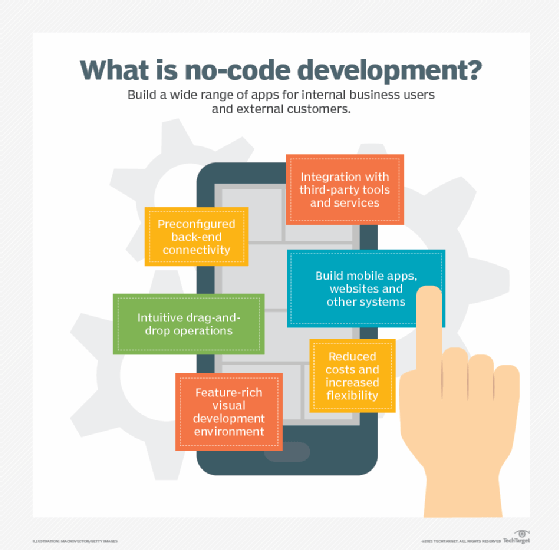Good Ideas On Deciding On Legacy application modernization with Low-code
The Benefits Of Low-Code Development For Non-Developers In Terms Of AccessibilityThe following key factors make low-code programming accessible to those who are not developers.
Drag-and-Drop Builders: Low-code systems provide drag-and-drop interfaces that allow non-developers, who do not requirement to write code to develop visually appealing applications. This makes development easier for people with technical background.
WYSIWYG editors: These "What You See Is What You Get" editors allow users to create workflows and interfaces that are similar to the final product. This makes it simpler to learn and use.
Simple Workflow and Logic Design
Visual Workflow Modeling: Users can design business procedures and logic for applications by using visual flowcharts or models. This is much more efficient than traditional programming techniques.
Pre-built Logic Components: Low-code platforms often contain pre-built logic components (e.g., conditional statements loops, conditional statements) that can be easily modified, eliminating the requirement for complicated coding.
Reusable templates and components:
Libraries of pre-built templates: Many low-code platforms offer templates for common applications which allow non-developers to start from a solid base and modify as they need to.
Reusable widgets and Modules by using modular or reusable widgets users can speed up the creation process by reducing the requirement for detailed technical expertise.
Tutorials and guide development:
Step-by-Step Instructions: Platforms typically provide guided development paths along with tutorials and suggestions to help non-developers with developing applications.
Interactive Tutorials - Interactive tutorials which allow you to engage with the platform will assist you in learning and build confidence.
Integration with Existing Tools:
Easy integration Low-code platforms are designed to easily integrate with the existing business tools and systems (e.g. CRM, ERP) permitting non-developers to create applications within their current workflows.
APIs connectors and APIs: These devices make integration easier by allowing non-developers (or even end users) to link their applications with external services.
Collaboration Features:
Team Collaboration: Features like real-time collaboration workspaces and shared workspaces allow for non-developers to effectively collaborate with business analysts, developers and other users.
Role-based Access Control: Developers can be assigned specific roles, with the adequate access levels to ensure they are able to contribute to the development process without compromising security and functionality.
Automated Testing and Debugging
Test tools are included: Many low-code platforms include integrated debugging and testing tools. These tools automate the process, making it easier for non-developers ensure that their applications are working correctly.
Platform identifies errors as they happen and provides solutions. This helps non-developers with troubleshooting.
The ability of low-code applications to allow development to non-developers is their biggest benefit. Through providing clear, intuitive tools and guided experiences low-code platforms enable business users to actively participate in creating and maintaining apps, thus bridging the gap between requirements of business and technical implementation. Follow the recommended her comment is here about Low-code Platform for application development for website advice including cloud software applications, application modernization, app modernisation, cross platform mobile app development, cross platform mobile app development, ms azure sql, push notifications, build with docker, build a docker container, application development platforms and more.

Low-Code App Development Has Many Benefits In Terms Of Cost-Effectiveness
Low-code app development offers a number of advantages, including cost-effectiveness. This is an appealing option for businesses who want to reduce development costs without compromising on quality. Here are the top benefits: Reduced Development Costs:
Less Coding Requirements: The low code platforms eliminate the need for extensive hand-coded, custom-built applications. Developers can spend less time and effort creating applications. This means less labor costs.
We require fewer resources for developers. Programming low-code is more efficient and quicker, so fewer developers with specialized skills are required. This could significantly cut down on hiring and staffing expenses.
Quicker time to market:
Accelerated Development: Low-code platforms include visually-based development tools, components that are pre-built, and other features that enable rapid development of software. Businesses can introduce their products on the market more quickly. This can translate into faster revenue generation as well as improved competitive positioning.
Rapid Prototyping: Businesses can quickly develop prototypes and then test them, reducing the time required in the development stage and allows for quicker iterations that are based on feedback from the users.
Low Maintenance Costs
Because of their modular design and standardised components, low-code platforms usually allow for easier maintenance of applications. This helps reduce the cost of ongoing maintenance.
Automated Patches and Updates: Low-code platforms can manage patching and updating applications completely. This means that the application is safe and always up-to-date with no manual intervention.
Efficient Resource Utilization:
Low-code platforms allow people who are not developers to take part in the development process. This allows businesses to take advantage of the talents of a diverse spectrum of employees.
Improved utilization of IT resources IT departments are given the opportunity to focus on more strategic initiatives, instead of getting bogged down with mundane development tasks. Overall efficiency and productivity are increased.
Scalable pricing models:
Subscription-Based Price: Many low-code platforms provide an affordable subscription-based pricing model that grows with usage. This allows businesses to alter their budgets to meet their requirements and needs without having to pay large initial cost.
Pay-as-you go options Certain platforms offer pay-as-you-go options that ensure that businesses only pay for the resources they utilize, which can be particularly useful for small and new companies with a limited budget.
Costs for reduced Third-Party Software:
Low-code platforms typically come with integrated functions that eliminate the need to purchase extra software or tools. This can save you money on subscriptions and licensing fees.
Pre-Built Integrations: Availability of pre-built integrations for popular systems and services reduces the need for custom development, thereby saving time and money.
Higher ROI
A faster return on investment (ROI): By combining rapid application development with lower costs and a shorter time to the market, businesses can get an increased ROI on their applications.
Improved Agility: Businesses can quickly adapt to changes in the market and the needs of customers and ensure that they remain current and take advantage of emerging opportunities when they occur.
Costs of training are lower:
Low-Code Platforms Have User-Friendly Interfaces. The simple and user-friendly interfaces cut down on the learning curve for new users. This eliminates the requirement for extensive training programs.
Accessible resources Low-code platforms often have complete tutorials, instructional materials, and community assistance which reduces the need for formal education.
Collaboration can be streamlined.
Improved Collaboration Tools : The collaboration tools built-in to the software aid in communication and coordination between team members. This results in an efficient development process as well as lower costs.
Unified Development Environment. A single unifying software development environment can simplify processes and reduce the complexity and expense of managing multiple software and platforms.
Low-code development is cost-effective because it lowers maintenance and development costs. It also reduces time to market as well as optimizes utilization of resources. Pricing models can be adapted. These factors deliver significant economic benefits to businesses, making low code an attractive option for businesses seeking to maximize their budgets and achieve robust, scalable, high-quality apps. Read the recommended click this link on Legacy application modernization with Low-code for site recommendations including build with docker, paas service, driver jdbc, rapid app development, application development platforms, rad development, push notifications, app dev platform, lowcode no code, rapid applications and more.

Support From Vendors And Community Are Two Benefits Of Low Code Application Development.
Low-code platforms offer significant advantages both in terms of community involvement and vendor support and vendor support, both of which are essential for success in the implementation, maintenance, and further improvement of apps. Here are the top advantages: Support from vendors
Comprehensive Technical Support:
Support Teams: Most platforms using low-code have special support teams that help with technical issues or troubleshooting, as well as guidance.
24/7 Support: Some vendors are available 24/7 This is useful for businesses operating in multiple time zones.
Training and Onboarding
Vendors typically offer structured programs for users including tutorials or webinars. They can also offer certification courses.
Customized Onboarding : Many vendors offer customized onboarding services which assist new customers implement the platform and customize it according to their specific requirements.
Updates and Enhancements, Regularly, and Enhancements:
Continuous Improvement: Low code platform providers release regular updates, which include new security patches, features and enhancements to performance. This ensures that the platform remains updated and secure.
Feedback Integration Vendors incorporate customer feedback into the development cycle to ensure that the platform evolves in response to the changing requirements.
Comprehensive Documentation:
Documentation is detailed: Users are usually able to access a wealth of well-organized documents, which range in terms of complexity from basic customization to advanced usage.
API References API documentation contains detailed API references to assist developers connect their low-code platform apps with other systems.
Consulting and Professional Services
Expert Consulting: Most vendors provide consulting services for strategic planning, architecture and complicated implementations. This assists users to maximize the capabilities of the platform.
Custom Development Services Certain companies offer customized development services to build specific features and integrations which are not available as standard.
Community Support for the Community
Active User Communities
Forums and discussion boards A lot of platforms with low-code have vibrant online community for users to ask for help, share solutions and collaborate in finding the most effective techniques.
User Groups and Meetings Virtual and local meetings and groups of users offer opportunities to learn about, network, and share experiences with other users.
Collaboration and Knowledge Sharing
Community-Contributed Resources: Users often share templates, modules, and extensions that they have developed, which can be reused or adapted by others, accelerating development and innovation.
Crowdsourced Problem Solving: The collective knowledge and experience of the community can be a valuable source for identifying issues and finding creative solutions to complex issues.
Learning and Development
Community-Led Learning: Several communities host training sessions, workshops and webinars which are typically directed by experts who can share their knowledge and techniques that are more advanced.
Tutorials and online courses Community members frequently develop and publish online courses, tutorials, and how-to guides, making better educational resources available to all users.
Feedback and Influence:
Product Feedback: Several community forums offer channels to give feedback to vendors. This can influence the design of new features or improvements.
Beta Testing Programs: Active community members could be able to be part of beta testing programs that give them early access to new features and an opportunity to participate in determining the future of the platform.
Recognition and Support
Community Recognition Programs: Several vendors have recognition programs to recognize the contribution of active community members for example, MVP (Most Valuable Professional) programs.
Peer Support : Community members give support to each other, sharing their experience and offering guidance. They build a supportive and supportive environment through sharing their expertise.
Overall, the combination of a robust vendor's support and a lively, active community offer a robust support system for low-code app development. This ensures that users are able to access the resources as well as the expertise and collaboration opportunities needed to successfully develop, deploy, and maintain their applications which ultimately improves efficiency and creativity.
